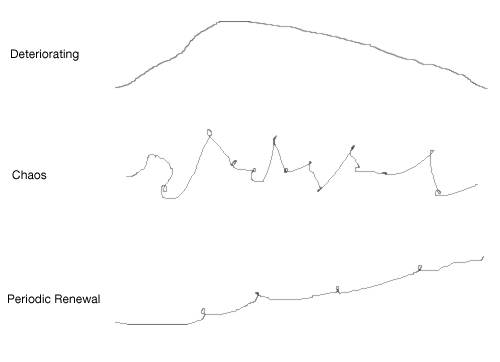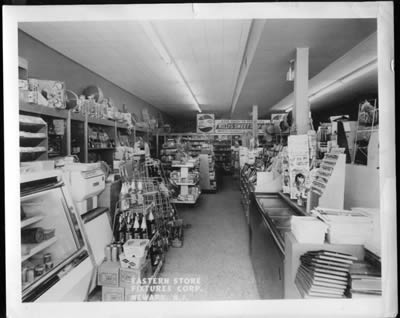“Some thoughts are like the digestive stones that birds swallow.” — Owen, in a conversation on change.
Month: January 2006
-
The wonderful world of concrete
If you’re in Washington D.C., do see the concrete exhibit at the National Building Museum, where you’ll learn that concrete does not have to be heavy, solid, opaque, flat, gray, or ugly. Quite the opposite.
-
Everything written about innovation is shitty and useless
Walking home from work tonight I was thinking that most everything written about innovation is useless. It’s generic banter. Fixing companies must be done in the context of their problems by people passionate enough to constantly push against the dead weight of status quo.
If we learn anything useful from the Tom Peters of this world, it’s the need for passion. Arriving home I read, hot on the heels of Culture eats strategy for breakfast, this beauty from Tom Peters…
If Drucker and Bennis and Collins and Peters and Co. (charter members of Guru Nation) are/were so damn smart-wise, why is corporate performance so shabby in general? …the “solutions” were not actionable by “real people” under stress….
Strategy don’t matter for diddly if the “corporate culture” [an anathema word at McKinsey at the time], is disfunctional/mis-aligned.” That is, if the “strategy” ain’t implementable, it’s de facto a shitty-useless strategy.
-
Interaction Design as Language Design?
 Marc Rettig, one of the most thoughtful practioners in the user experience world, will be in New York next month discussing Interaction Design is Language Design…
Marc Rettig, one of the most thoughtful practioners in the user experience world, will be in New York next month discussing Interaction Design is Language Design……The notion of a “design language” has been with us for years, but if we take the idea seriously, perhaps ideas and frameworks from linguistics can help us design better interfaces. The goal of the topic is to create a grounded practice using the explored principles. The seminar is not meant to be a completed theory, but a work in progress that participants get to explore with Marc during the seminar and after on their own work.
-
Four Things
I usually don’t participate is such folly, but I’m feeling frivolous…
Four jobs I’ve had:
- painting playgrounds
- building houses
- administering computer networks
- writing about music
Four
moviesalbums I canwatchlisten to over and over:- Steely Dan’s Aja
- Death Cab For Cutie’s We Have the Facts and We’re Voting Yes
- Mahler’s Tenth Symphony
- Led Zepplin II
Four places I’ve lived:
- West 23rd, between Ninth and Tenth
- West 25th and Seventh and Eighth
- West 87th between Central Park West and Columbus
- 28th St between Ditmars and Twenty-Third, Astoria
Four TV shows I love:
- M*A*S*H
- The West Wing
- The Newsroom
- Connections
Four places I’ve vacationed:
- Charleston
- Sienna
- Berlin
- Dublin
Four of my favorite dishes:
- koenigsberger klops
- fish tacos
- pasta fagioli
- anything from Ben & Jerry’s
Four sites I visit daily:
- New York Times
- ?
- ?
- ? …besides scanning RSS Feeds, it’s interesting that the sources I look to on a daily basis — books, the New Yorker, the Wall Street Journal — are still more satisfying offline, though I’d rather have them online.
Four places I would rather be right now:
- the bathtub
- a sidewalk cafe
- cycling through the countryside
- with friends
-
Is Angie a design thinker?
German Chancellor Angela Merkel is making waves at Davos. I like her attitude: “She acknowledged the political necessity to move ‘in small steps.’ She added, ‘In Germany, sometimes things never get going because one doesn’t know how it will work out, and maybe it’s better to do nothing. That’s not my maxim.’“
-
MIG Seminar in Vancouver, March 23
We’ll be teaching a full-day seminar prior to the IA Summit called Enhancing Your Strategic Influence: Understanding and Responding to Complex Business Problems. I’ll be joined by John Zapolski and Scott Hirsch of MIG, Harry Max (formerly of Dreamworks), and Mark McCormick (Director of Design at Wells Fargo).
We’ve been designers. And we’ve partnered with companies to work through tricky business issues. Now we want to return to the design community and teach the many skills we’ve learned.
Here’s the official description:
While the skill level of the average information architect has increased dramatically over the last several years, many IAs still lack the tools necessary to understand and articulate the broader implications of their work within a complex and dynamic business environment. The most successful information architects are better at recognizing the roots of strategic change and opportunity, assessing the potential impacts on their organization, and determining what to do and who to involve in getting it done.
This workshop introduces participants to a new way of thinking about cause and effect in complex organizations—within functional groups, across departments, beyond business units, and across industries. Participants come away with a set of tools to identify social, cultural, economic, and technological change, match products to emerging and changing markets, develop strategies to capture market value, and change organizational capabilities to reflect changing market and technological dynamics. Special attention is given to learning how to create and maintain a workplace and culture that facilitate and sustain innovation and change.
Here are some of the basic questions that we will help participants answer, both in general and in the context of their companies:
- What is a business model? A value proposition? A business strategy?
- Given my role, what contribution am I making to my company’s success?
- How does IA/UX deliver value in my company’s business model and value proposition?
- How do I determine how to choose my battles wisely: which high-value projects to push and which can stay on the back burner?
- How do I say “no†to bad projects? What language will be most convincing to my management and stakeholders?
- How can I get more visibility for IA/UX in my company? How do I build alliances with like-minded stakeholders?
- How do other functions typically understand business problems, and how does that compare to the IA perspective?
This session is designed specifically for managers and leaders who seek to use IA as a strategic tool to understand and influence organizational change. While a deep knowledge of advanced IA principles is not necessary for this session, participants should be willing to explore their roles as leaders and change agents within their organizations.
Types of attendees most likely to find this workshop compelling include:
- Managers of IA/UX teams
- Product Managers
- Entrepreneurs seeking to build a culture that values IA/UX design
- IA/UX practitioners who report to a non-designer manager
- Anyone who aspires to enhance their role as an internal change agent
-
The Innovate-Dominate Imperative
This essay by Ray Lane of Kleiner Perkins offers some useful models of the software industry that could easily apply to similar industries in a state of major transition.
This year, many software companies will be busy trying to convert their offerings from products into services. In fact, I would estimate that last year, software-as-a-service (SaaS) was the number one item on the agenda of 70 percent of software executives.
I’m here to tell you that this is a mistake.
…The enterprise software companies that move to innovate and dominate today will be the most successful companies five years from now.

-
Ford’s “Way Forward”
Quotes from the Wall Street Journal…
Ford will announce a plan tomorrow called “The Way Forward” that will involve 30,000 layoffs and target “the root of the auto maker’s recent woes: a stifling corporate culture.”
[In the war room,] high on the wall, hangs a big, white sheet of paper on which is written: “Culture eats strategy for breakfast.”
Among other maxims on the wall: “Culture is unspoken, but powerful. It develops over time — difficult to change.”
…implores employees to remember “conflict is healthy.“
-
A Recipe for a Decision-Making Bottleneck
The latest HBR offers a pleasing overview of decision making. The below callout is from Who Has the D? by Paul Rogers and Marcia Blenko…
A Recipe for a Decision-Making Bottleneck
At one automaker we studied, marketers and product developers were confused about who was responsible for making decisions about new models.
When we asked, “Who has the right to decide which features will be standard?â€
64% of product developers said, “We do.â€
83% of marketers said, “We do.â€
When we asked, “Who has the right to decide which colors will be offered?â€
77% of product developers said, “We do.â€
61% of marketers said, “We do.â€
Not surprisingly, the new models were delayed.
-
European School of Management and Technology
 In Berlin over the holidays, we walked passed this beautiful building with a classical center and modern wings. It’s the former Staatsratsgebäude (East German government center), the portal from a pre-war city palace which the East Germans built around. It was recently restored and only days away from the becoming the Berlin campus of the European School of Management and Technology.
In Berlin over the holidays, we walked passed this beautiful building with a classical center and modern wings. It’s the former Staatsratsgebäude (East German government center), the portal from a pre-war city palace which the East Germans built around. It was recently restored and only days away from the becoming the Berlin campus of the European School of Management and Technology.This is a curious thing, as the Germans embrace a greater sense of class equality than, say, the United States. Private schools are rare, and the absence of a world-class management or economics school is conspicious when the Brits, Swiss, and French sport such institutions. My wife explained the formation of this school was controversial, and when laws govern whom a university may hire as a professor, I’ll be interested to see how entrepreneurially they can function.
I will say the spirit of the place, based on the language on their website, strikes a chord with a progressive, creative type like myself. Listen to this:
Our school is inspired by the Bauhaus vision. Our commitment to this tradition places us in direct line with the principles of the founding members of the Weimar Bauhaus around the person of Walter Gropius. The latter gave substance to the daring idea to make creativity in architecture and design subject to the mastery of technical craftsmanship, and in this manner, to eliminate the boundary between free and applied arts. In the same way that the Bauhaus elevated the role of craftsmanship at the time, the application of managerial knowledge is intended to attain a radically new status at esmt…
This means engineers and scientists who can turn technology into profitable business, financial professionals who can go beyond analysis, architects and lawyers who can develop and lead new business…
-
Full-on cocktails, plus panel discussion, Feb 28 in NYC
 If you’ll be in New York at the end of February you should consider attending the Design 2.0 day of presentations and panel discussion on strategy, design, brand, product, service, customer experience, and all things innovation. Also, full-on cocktails. Among the speakers will be Andrew Zolli, of whom I’ve written, “If you ever get a chance to hear Andrew Zolli make sure you do.” So really, no reason not to go. See you there!
If you’ll be in New York at the end of February you should consider attending the Design 2.0 day of presentations and panel discussion on strategy, design, brand, product, service, customer experience, and all things innovation. Also, full-on cocktails. Among the speakers will be Andrew Zolli, of whom I’ve written, “If you ever get a chance to hear Andrew Zolli make sure you do.” So really, no reason not to go. See you there! -
Periodic process renewal
There’s a funny (or cruel, depending) dilemma to improving your work over time. If you don’t do it, your organization becomes less and less valuable over time, gradually failing, and dying an unfortunate death. If you do all the time, you never get to benefit from each change very long and probably suffer from change fatigue. We’ve even labeled these positions in our worldviews: conservatives want to keep things just the way they are – thank you very much – and progressives always want to embrace the something better that’s just around the corner.
My fix for this is simple: Instead of never changing or constantly changing, set a regular period when you revisit your process. And just so you’re pretty sure the change is leading to improvement, have a simple way to keep track of what you did, why, and what happened as result. Not every change will result in improvement, but at least you’ll know that and not repeat your mistakes.
We can look at this in evolutionary terms using the example of sharks. A shark doesn’t evolve constantly, it evolves by having baby sharks (which are amusingly called pups) that have unique DNA that make them more or less successful than their parents. While each shark is alive, her life is a time of trying out her DNA and either succeeding or failing to have her own pups. Reproduction is a time of trying slight variations (aka gene mutation) on what worked before and only passing on the DNA of successful sharks. Over time, sharks become more and more successful at being sharks.
I’ve started developing a simple model of the nature and frequency of process change in companies based on what I’ve seen in the dozens of companies I’ve worked for or with. The model boils it down to three types:
- Deteriorating: When the company was young they designed and established productive methods, but over time the methods gradually lose value as the environment changes. We see this trend in the Management Practices across Firms & Nations survey.
- Chaos: Change is constant, usually reactionary, and there’s little history of past changes to help judge the effectiveness of future changes.
- Periodic Renewal: The company designs and establishes some methods and measures the results, periodically revisiting them and making improvements.
I might draw them like this:

And I might track the change over time like this:
(diagram coming soon)Periodic renewal requires the organizational discipline to stick with what works as well as the resolve to occasionally improve it, a careful balance. For many companies, the closest analog is periodic performance reviews. We don’t formally judge our colleague’s performance and award raises every day, we do it periodically (or suffer the wrath of seriously pissed off colleagues). How good is your performance review process? Judging your ability to improve this process over successive versions may indicate your current ability to institute periodic renewal of other processes.
-
Employee-Customer mashups
For the sake of innovation, it’s tempting to mash up people internal and external to a company. We’ve seen how important it is that employees be customers, like JetBlue’s employee-centered priorities, and how customers can contribute to companies. This could be one of the most important changes in culture we can bring to companies, but not one of the easiest. Beside the discomfort it will arouse in traditional corporate cultures, we’re still figuring out how to do it.
For example, I’ve realized lately in working to co-create with clients that it needs to be gradual process, because the party you’re creating with doesn’t share the same content or process and needs time to learn. Rather than strive for immediate immersion in creation, I’ve taken a hint from surgeons who say, “watch one, do one, teach one.” Spreading these steps over whole projects may be necessary for both learning and change to happen.
Two more examples come from friends who have recently launched exciting projects that mash up “internal” and “external” resources. Christina Wodtke — a co-founder of MIG — has launched Public Square, software that recognizes the importance of reader-contributed content by allowing quality rankings of people and content to better balance editorial direction and reader input.
And Lou Rosenfeld just launched Rosenfeld Media, a publishing venture in which readers play a vital role in everything from deciding which topics get covered to influencing the actual authoring decisions.
-
Consumer control and grocery shopping
Another way to illustrate the evolution of consumer control…

Shopping in 1920, photo courtesy Theodor Horydczak
Shopping in 1960, photo courtesy Country Joe
Shopping in 2005, photo courtesy Nicole Gesmondi